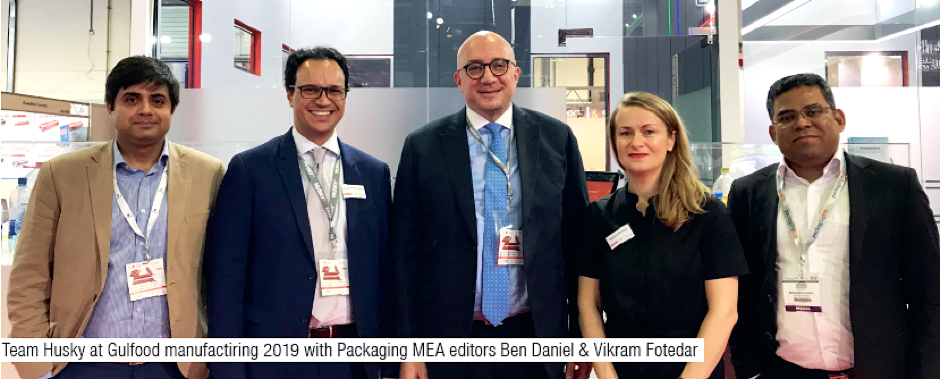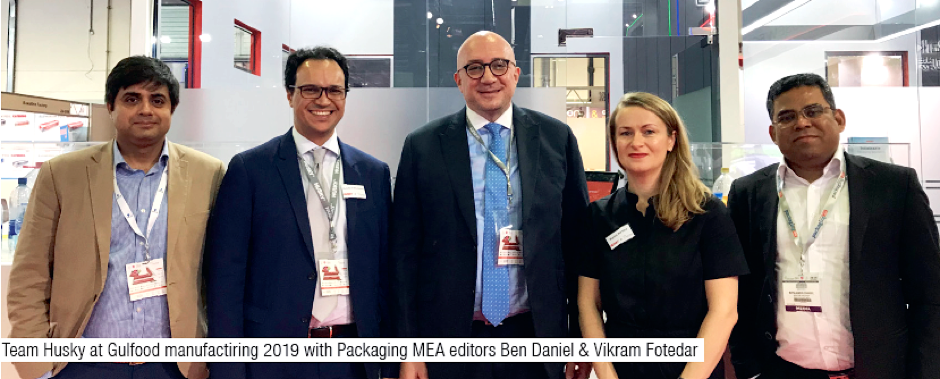
Today’s new generation of consumers are looking for more diverse, unique, personalized products, a catalyst driving plastics producers to develop packages of different sizes, shapes and colors. As a leading plastics industry supplier and pioneer,Husky strives to provide integrated solutions that offer the lowest total cost to produce, freedom in packaging design, reduced operational risks, and parts that are optimized for the molding process and end consumer.
Husky offers a variety of injection molding solutions based on varying application and production needs. At the show the company is highlighting its new versatile HyPET®5e PET systems portfolio, its flexible, lower cavitation NexPET™ system and mold, as well as its Next Generation Operating Model (NGOM), a digitalized end-to-end manufacturing system delivering unmatched speed and flexibility.
Husky is showcasing its Multi-Layer Technology capabilities, offering tremendous opportunity to unlock the potential for conversions from alternate packaging, such as glass, carton and aluminum, to PET. Here at GFM, we are demonstrating how it’s Multi-Layer Technology satisfies various application requirements, including barriers for light, oxygen and carbon dioxide, as well as bottles that dramatically enhance shelf appeal.
On the booth, Husky is featuring a wide range of applications that can be manufactured in PET, including packages with exciting design and functional treatments, increased recycled content and light weighting capabilities and tethered closure designs to meet recycling and packaging legislation.
As for the company’s equipment and services for the plastics industry Wassim Labban said, “Husky offers an unmatched level of global support in more than 40 countries and a range of aftermarket services to keep equipment running at maximum efficiency. Value-added services include preform development, part optimization, factory planning, customer training, systems integration and complete asset management.
Q&A
Packaging MEA (PMEA): Single use plastic has been attacked. What is Husky doing about this?
Wassim Labban (WL): Husky is into multiple types of packaging but our presence is largely in beverage packaging which is PET and equipment used to make PET preforms which is later used to make bottles. With regard to single use plastic, it is still unclear if PET is considered as a single use plastic in terms of one time use of the plastic or whether referred to from the life span / recyclability aspect. Note that PET is 100% recyclable.
This is the primary reason some of the countries in Europe don’t define PET as single use plastic. One of the many roles of Husky is to create awareness that not all plastics are the same. PET is good in terms recyclability, efficiency, energy, CO2 emission perspective, whether to produce or recycle it and still compete and lead if compared with other substitutes like aluminum/glass/ carton etc. PET as a material is still the best solution for pack liquids.
Today environmental hazard is the primary concern and it is the responsibility of the stakeholders like Husky, NGO’s, social groups etc. to address and correct this by collecting and reusing the same.
PMEA: You have a patent with multi-layered PET. How successful has it been in our region Middle East and Africa)?
WL: MEA were early adopters for various reasons for example carbonated soft drink because it is presented in smaller packs that will address concerns like sugar content, calorie intake etc. For most of the companies in this part of the world, when it comes to putting a barrier, it aids logistics in terms of easy reach to places which posed difficulty in terms of distance/time factor etc. Most of the companies want to address millennial’s and young consumers. They find it difficult to get their attention with traditional packaging styles. This is another reason why companies are interested in having a range or part of their portfolio in PET bottles.
A global CSD brand was initially blending nylon, however they later switched into having an inserted layer of pure nylon that is easier to separate and recycle. This has helped them fulfill their environmental and sustainability objectives and has been well received in Pakistan and other countries. In addition to being more environment friendly the packaging is also lighter and yet offers greater functionality in terms of shelf life. Some of the companies adopted putting the recycled material in the middle layer. So on one side you have PET suppressing the middle layer. So for milk bottles we can insert the black layer recycled content and recycle it and put it back in the middle layer.
Multilayer barrier technology is turning out to be the premium product. Very soon we will have products for premium bottle using the multilayer technology for decoration for aesthetic purpose. In the Middle East there is a market for premium products and we believe that this is the segment where multilayer can offer added value for the product on the shelves in addition to products like shampoos, personal care to attract millennials. To find new end users/consumers they like to come up with innovative designs and colors.
PMEA: Do you have any example on how premium-ness is added by multilayers?
WL: Typically for water bottles, companies may like to offer premium water that is served in restaurants or in hotels and they want to do away with traditional bottles, which is transparent, with innovative color inside. We introduced color in the middle layer like florescent color, color which shines in the dark for night clubs. Some of the premium bottles that are used in governmental places where they want to introduce golden color which doesn’t color the full bottle. It gives a very nice aesthetic effect.
PMEA: There have been talks that airports will be banning single use plastics. Would it be fair to assume that anything below half a liter or 250 ml is considered single use as one would drink it and throw?
WL: I think so. If it is to be imposed in this category where I mentioned about PET being recycled and not single use as a material, probably it will be for 200ml and less because lately we started with 150ml or 100ml which is a smaller pack and in some cases, unless there is a necessity maybe for stadium or aircrafts or safety need, maybe it could fit. I don’t think because it is recyclable and that it is a must because if people really want to ensure that bottles are affected, according to me it will be below 200 ml or 150ml.
PMEA: In that case there is no cause for concern for any of your customers with install base for preforms in terms of legislation that might prevent them continuing to manufacture for certain markets?
WL: Personally, I don’t see it as a concern in this part of the world as it was in the K show where it was a priority. I don’t see it as something that will hinder our business. Airports are using mainly premium package not high volume packs.
PMEA: Another topic we plan to incorporate in our magazine is initiatives on digitization by various companies to improve the overall equipment effectiveness of assets and getting into an asset management role.
WL: This topic is vast for discussion. In a nutshell Husky, in our field, we are leading the digitalisation process in our own capacity /enable our customers to do it and in last 2 years we have invested around $100 million and to ensure improvement in digitilisation in our factories in an effort to add value from cost perspective, lead time, production time and connectivity with our customers to ensure better integration for our customers in manufacturing line. Our new innovation is all about digitalised access for customers and digitalised production, change overs for machines. This is high priority to sustain our presence in this industry and also to sustain this industry itself. The intention is to make integration between the customer and technology provider more direct and eliminate the buffer.
PMEA: What is Husky’s plan for the region? There are some companies building experience centers in Dubai and what are Husky’s plan on engagement in the region?
WL: We have ensured that we have our own sales/service team in the region. We want to be actively involved in delivering our message to our customers and getting a feedback from the market. We have our own team based locally. We started our office in Dubai in 2002 and have now expanded. Today we have a sales & service team, business development team who can analyse the business trends and these are regional roles. We have local team to study the local trends and communicate how to adopt our products/technologies to better serve the need/requirement in this region. We have a technical center in India.
PMEA: What is your message for our readers? How has Husky set itself apart from its competitors?
WL: Husky has always associated with innovation and after sales service. We study the need and requirement in the region and then we help our customers to grow in terms of technology/support/ commitment.
We supply premium equipment with competitive price. Husky is reliable and believes in commitment. We have experts in our field, providing needed guidance and advice to our customers.



